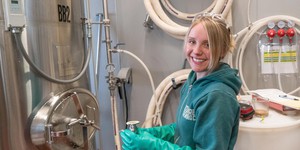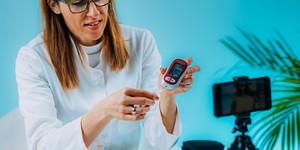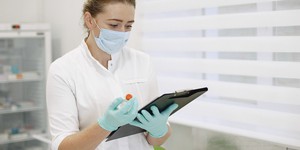Abstract
No one likes shots, so why don't we swallow all our medications? In this science project, you will use a model to explore one challenge behind making medications we can quickly swallow, using insulin (a medication taken by some diabetes patients) as an example. Will your medication be functional after spending time in an environment similar to the stomach?Summary
Objective
Use jello shapes to model insulin (a medication) and test if, in your model, insulin is functional after being soaked in enzymes found in the stomach.Introduction
Have you ever wondered why some medicines can be swallowed as pills or liquids, while others have to be injected in the form of shots? In this science project, you will explore why not every medication can be given in pill form or liquid form using insulin as an example.
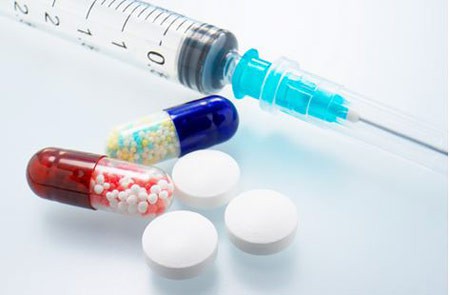
Figure 1. Not all injections can be replaced with pills or liquids.
If you have heard of diabetes before, you have probably also heard of insulin. You may already know that people with Type 1 diabetes make no insulin, and people with Type 2 diabetes have bodies that do not have a strong response to insulin (they are insulin resistant). But what is insulin, and why does it matter if your body responds to it? Insulin is a protein that acts as a chemical messenger and opens up cells to absorb glucose, a type of sugar your body uses for energy. Insulin's job is to help make sure there is just the right amount of glucose, in your blood. Glucose is a little bit like the story about Goldilocks and The Three Bears. Like Goldilocks, your body is happiest when the levels of glucose are just right. Both too much glucose and too little glucose can make you sick, and, in some very specific circumstances, even kill you. So, to stay healthy and happy like Goldilocks, diabetics (people with diabetes) need to keep track of their blood glucose levels to make sure they stay in the "just right" range.
According to the Center for Disease Controls and Prevention (CDC), approximately 6 million Americans, all type 1 diabetics and a significant percentage of type 2 diabetics, require doses of insulin. For these patients, that means injecting a liquid form of insulin. Why a liquid injection rather than a pill or syrup to swallow? There are several reasons, but one major one that we will focus on here is that when you inject medicine, like insulin, it goes directly in to your blood. In contrast, when you swallow a pill or liquid the medicine first travels through your digestive system as shown in Figure 2, where it is eventually transferred to your blood.
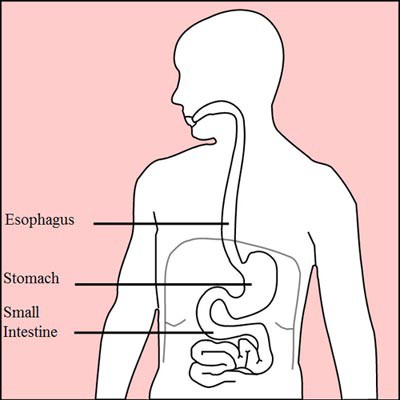 Image Credit: Wikimedia Commons / Public domain
Image Credit: Wikimedia Commons / Public domain
Figure 2. Swallowed medication travels from your mouth, down through your esophagus, and to your stomach. This diagram shows only part of the entire digestive system.
While in your digestive system, the medicine encounters proteases. Proteases work to break down proteins, like the proteins your food is made up of, into smaller parts. This is important for digestion because the smaller parts can be absorbed by your body and used as nutrition. The same proteases may also act on medicines that are in the stomach. Some medicines, like aspirin, are already quite small and are not proteins, so they are not broken down or changed by proteases. But medicines that are proteins may be broken into smaller pieces or have their shape changed by proteases. Often, changing the length or the shape of a protein also changes its function. In that way, proteins are like keys—their exact shape determines if they will be able to do their jobs properly. What do you guess (hypothesize), based on the information you have, will happen to insulin when it meets up with proteases in the stomach?
In this science project you will use jello cut into shapes with a cookie cutter as a model for insulin. Each jello shape will represent a single insulin protein. You will test what happens to the shaped jello (insulin) when it is placed directly into plain water, an environment similar to injecting insulin into the blood, versus what happens to the shaped jello (insulin) when it is placed in water with proteases, an environment similar to swallowing an insulin pill. Meat tenderizer, found in the spice aisle of the grocery store, is full of proteases (see technical note), so making water with proteases is very simple—just add meat tenderizer to plain water. Table 1 can help you keep track of what each thing represents in this model.
| In the Human Body | In this Project | |
|---|---|---|
| Insulin proteins | Jello shapes | 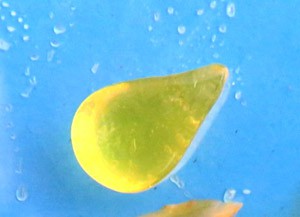 Image Credit: Sabine De Brabandere, Science Buddies / Science Buddies Image Credit: Sabine De Brabandere, Science Buddies / Science Buddies
|
| Blood | Red-colored water | 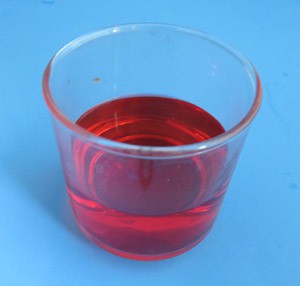 Image Credit: Sabine De Brabandere, Science Buddies / Science Buddies Image Credit: Sabine De Brabandere, Science Buddies / Science Buddies
|
| Proteases solution found in the stomach | Proteases solution created by dissolving meat tenderizer in water | 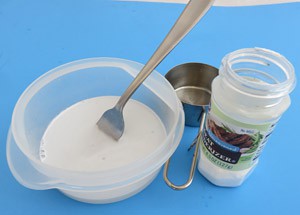 Image Credit: Sabine De Brabandere, Science Buddies / Science Buddies Image Credit: Sabine De Brabandere, Science Buddies / Science Buddies
|
| Insulin proteins injected in the bloodstream | Jello shapes placed into the red-colored water | 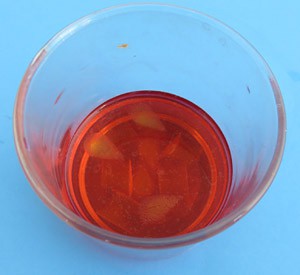 Image Credit: Sabine De Brabandere, Science Buddies / Science Buddies Image Credit: Sabine De Brabandere, Science Buddies / Science Buddies
|
| Insulin proteins taken by pill | Jello shapes placed into proteases solution | 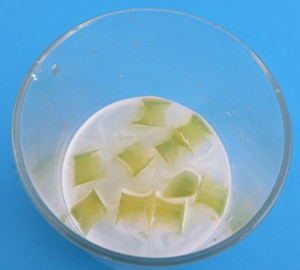 Image Credit: Sabine De Brabandere, Science Buddies / Science Buddies Image Credit: Sabine De Brabandere, Science Buddies / Science Buddies
|
| Functional insulin proteins | Jello shapes fitting back inside the cookie cutter | 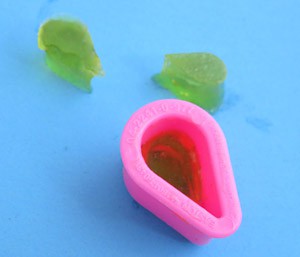 Image Credit: Sabine De Brabandere, Science Buddies / Science Buddies Image Credit: Sabine De Brabandere, Science Buddies / Science Buddies
|
What do you think will happen to the jello shape (insulin) when placed in the blood (colored water)? How is that similar or different from what will happen to the jello shape (insulin) going through the stomach (proteases solution)? From your experiments with this model, what do you expect to be able to conclude about the challenges behind making an insulin pill that can function properly to help control blood glucose levels? Based on your experiment, can you make any generalizations about what kinds of medicines (not just insulin) would be difficult to put into a liquid or pill form?
By the way, creating a working insulin pill is a problem scientists are actively working on! Check out the Bibliography for an article about how researchers at Novo Nordisk are tackling the problem. It is worth noting that how the insulin protein tolerates being in the stomach is just one variable the researchers are looking at. How much insulin can be absorbed through the stomach and into the body, how quickly absorption can happen, and how to adjust the dose for different patients are all additional questions! It is likely to turn out that a pill form of insulin only works for some diabetics; it is a better potential treatment for Type 2 diabetics who need a small insulin boost rather than Type 2 diabetics who need more customized insulin doses or Type 1 diabetics who need to constantly adjust their insulin doses based on what they are eating, exercise, and other factors.
The proteases in meat tenderizer will be listed as papain or bromelain on the ingredients list. This project treats the presence or absence of meat tenderizer as a single variable. A more advanced project could look at the different ingredients in meat tenderizer separately and see which ingredient has an effect. Explanations in the Variations can help you get started.
Terms and Concepts
- Diabetes
- Insulin
- Glucose
- Digestive system
- Protease
Questions
- Why is insulin in pill form so desirable?
- How can the digestive system—especially the solutions found in the stomach—alter medicine so that the medicine might no longer be able to do its job in the body?
- In this science project, you will study what might happen to the medicine in an environment similar to the stomach. Do some background research and study which other challenges might be encountered when making medicine in pill or liquid form.
Bibliography
- Nelson, K. (n.d.). Biology for Kids: Human Digestive System. Ducksters. Technological Solutions, Inc. (TSI). Retrieved July 23, 2015.
- Nelson, K. (n.d.). Biology for Kids: Enzymes. Ducksters. Technological Solutions, Inc. (TSI). Retrieved July 23, 2015.
- Sanofi-Aventis. (n.d.). How Insulin Works. Retrieved August 4, 2015.
- Novo Nordisk. (2013 October). Insulin in a tablet - why is it so difficult?. Retrieved July 23, 2015.
For help creating graphs, try this website:
- National Center for Education Statistics, (n.d.). Create a Graph. Retrieved June 25, 2020.
Materials and Equipment
- Unflavored gelatin powder (5 packages or 1 1/4 ounces [35 grams])
- Baking pans or plastic containers (2); 9 inch diameter round baking pans or 8 inch square baking pans work well.
- Cooking oil, to grease the baking pans (a few drops)
- Paper towel
- Measuring cup (1 liter or 4 cups or larger)
- Alternatively, you can use a large bowl and a smaller measuring cup
- Fork
- Room-temperature water
- Boiling water
- Food coloring (red and a second color), preferably liquid
- Small cookie cutter. A simple shape like a circle or oval works best. The cookie cutter must be small, 1–3 centimeter diameter works well.
- Spatula
- Cutting board
- Wide glasses or containers; they can be two different types (2)
- Meat tenderizer (2 containers or at least 100 grams). This can be found in the spices aisle of the grocery store.
- Although you might only need 1 container, keep a second handy just in case you need more proteases solution.
- Spoon or slotted spoon
- Clock or timer
- Lab notebook
Experimental Procedure
Preparing Your Materials
In this science project, you will use jello shapes to represent insulin (a medication), red-colored water to represent blood, and a proteases solution to represent the environment of the stomach. This section will be your guide as you make these components. You can also watch the why aren't all medicines pills video for an introduction and overview of this project.
- To make the jello shapes, start by preparing a firm jello. The process is shown in Figure 3.
- Grease the insides of both baking pans with a paper towel and a few drops of oil. This will help the jello to easily come out of the mold.
- Pour 250 milliliters (mL) (about 1 cup) of water in a large measuring cup. Add a few drops of food coloring. Any color except red works well.
- Dissolve five packages (1 1/4 ounces or 35 grams [g]) of unflavored gelatin powder in the colored water. Stir well and let rest for one minute.
- While you wait, have an adult help you heat 3 cups of water until boiling.
- With an adult's help, add the hot water to the dissolved jello.
- Stir until all the gelatin is dissolved.
- Pour the hot liquid evenly into the two baking pans. The jello should be about 1 to 1.5 centimeters high in both pans.
- Chill until firm.
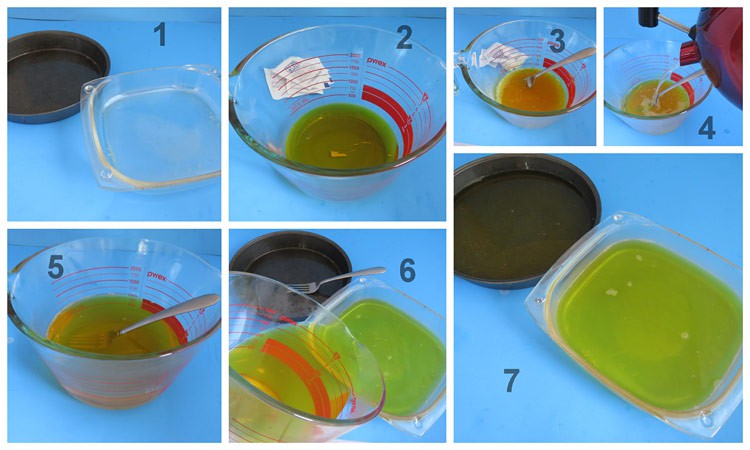 Image Credit: Sabine De Brabandere, Science Buddies / Science Buddies
Image Credit: Sabine De Brabandere, Science Buddies / Science Buddies
Figure 3. The steps to prepare the firm jello are shown in this group of pictures.
- While you wait for the jello to cool, select your small cookie cutter. Choose a simple shape, like the shapes shown in Figure 4. It is important to choose a small-sized cookie cutter for this project. A diameter of 1 to 3 centimeter works well. The three cookie cutters shown on the right in Figure 4 would work for this project. The cookie cutters shown on the left, with the "X" through them are too large.
 Image Credit: Sabine De Brabandere, Science Buddies / Science Buddies
Image Credit: Sabine De Brabandere, Science Buddies / Science Buddies
Figure 4. The cookie cutters shown on the left, with the "X" through them are too large. It is important to select a small cookie cutter, like those shown on the right. The gray arrow in the bottom right corner shows the scale used in the figure, it is 1 centimeter (cm) long.
- Transfer both jello molds to a cutting board.
- First, carefully glide a spatula along the sides and under the jello, as shown in Figure 5. Do not try to pry the jello out of the molds. Just loosen each jello mold from the edges.
- Next, place the cutting board over one of your molds, hold both the pan and the cutting board together, then turn both of them over so the jello falls onto the cutting board.
- Do your best to get the jello out in one piece, but do not worry if it breaks.
- Repeat this step with the second mold.
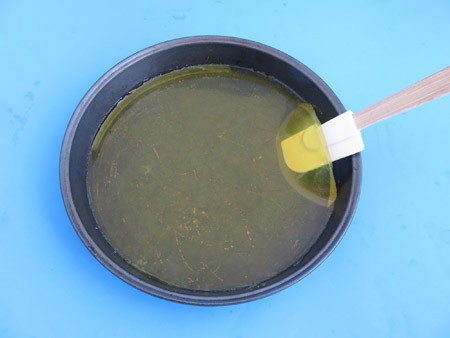 Image Credit: Sabine De Brabandere, Science Buddies / Science Buddies
Image Credit: Sabine De Brabandere, Science Buddies / Science Buddies
Figure 5. Glide a spatula along the sides of the jello before transferring the jello to a cutting board.
- Use your cookie cutter to cut 20 shapes out of your jello, as shown in Figure 6 (left picture). These shapes will model insulin.
- Take pictures of the jello shapes and make notes of their appearance before continuing with the experiment.
- To make red-colored water (modeling blood), add water to a glass or wide container until you have a shallow layer of water. Add a few drops of red food coloring. The color will remind you that this solution represents blood; the food coloring has no other effect on the experiment.
- To create the proteases solution:
- Pour 1 cup (about 100 g) of meat tenderizer into your other wide glass or container.
- Add 1 cup of water. Stir well.
- Some meat tenderizer might sink to the bottom; that is okay.
- Figure 6 shows the main components of your model: jello shapes modeling insulin, red-colored water modeling blood, and proteases solution modeling the environment in the stomach.
 Image Credit: Sabine De Brabandere, Science Buddies / Science Buddies
Image Credit: Sabine De Brabandere, Science Buddies / Science Buddies
Figure 6. Insulin (jello shapes), blood (red-colored water), and stomach environment (proteases solution) are the components of the model used to test if insulin can survive in an environment similar to the stomach.
Performing the Test
In your test, you will model insulin (jello shapes) being ingested and passing through an environment similar to the stomach (proteases solution) versus insulin being injected in blood (red-colored water). You will observe what happens to the jello shapes (insulin). What do you expect will happen? Will insulin (jello shapes) keep its shape so it can perform its function of "unlocking" cells? Before you do your test, be sure to write down a hypothesis in your lab notebook.
- Start by labeling your two containers based on what test condition they represent. Label the container with the red water "blood" and the container with the protease solution "stomach."
- Place 10 jello shapes in the wide glass containing red-colored water. Add more water if you need to so that all jello shapes are submerged. If the shapes are going to be lying on top of each other, carefully transfer everything into a wider container.
- Repeat step 2, now putting shapes in the proteases solution. You might notice that in this solution the jello shapes float, even if you add more protease solution. This is ok. The experiment will still work even if the jello shapes are not fully covered with protease solution. Make sure though that the shapes are not lying on top of each other. Figure 7 shows what the setup might look like.
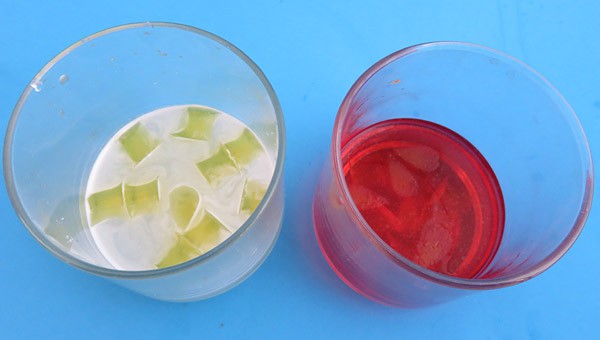 Image Credit: Sabine De Brabandere, Science Buddies / Science Buddies
Image Credit: Sabine De Brabandere, Science Buddies / Science Buddies
Figure 7. Insulin (jello shapes) are placed in a proteases solution and in blood (red water) for 2 hours.
- Let them sit for 2 hours at room temperature.
- While you wait, make a data table like Table 2 in your lab notebook. It will help you record your observations.
| Does the jello shape keep its shape? (Yes/No) | ||
|---|---|---|
| Jello submerged in red-water | Jello submerged in proteases solution | |
| Shape 1 | ||
| Shape 2 | ||
| Shape 3 | ||
| ... | ||
| Shape 10 | ||
| Number of shapes that keep their form after 2 hours | ||
- After 2 hours, use a slotted spoon to carefully take out the jello shapes from the red solution, one by one. Put each jello shape, one by one, in the cookie cutter and decide whether or not it fits snugly inside the cookie cutter. Again, take pictures and record your findings for each jello shape in your data table.
- Remember from the Introduction that the jello shapes are modeling what happens to insulin. To be functional insulin must be the correct shape.
 Image Credit: Sabine De Brabandere, Science Buddies / Science Buddies
Image Credit: Sabine De Brabandere, Science Buddies / Science Buddies
Figure 8. Jello shapes are placed back into the mold to observe if they maintained their shape.
- Repeat step 6 for the jello shapes submerged in proteases solution (modeling the environment found in the stomach). Record your findings in your data table.
- When you look at and touch the jello shapes, do you see or feel any differences between the ones soaked in red-colored water versus the ones soaked in proteases? If you do, but you could not measure a difference when you did the cookie cutter test, try soaking the shapes for 2 more hours in their solutions, then repeat steps 6 and 7. Be sure to make a new data table and use this table for your analysis.
Analyzing Your Data
- Using your data table, count how many of the 10 jello shapes kept their shape after being submerged in red-colored water. Record your total in the last row of your data table.
- Repeat step 1 for the jello shapes emerged in proteases solution.
- Optional: More-advanced students can translate the total number into a percentage of the number of shapes tested.
- To represent your data in a bar graph, place the environment ("Blood" and "Proteases Solution") on the horizontal (x-axis) and the number of jello shapes that kept their shape on the vertical (y-axis). Do not forget to label your graph and axes. Advanced students can graph the percentages. You can make your graphs by hand or you can make your graphs online using Create a Graph.
- Look at your graph, what does it tell you? Does jello hold its shape when soaked in red-colored water? How about when it is soaked in proteases solution?
- Remember, this experiment models what happens to insulin in the human body. From your data, does it seem like insulin (jello shapes) would keep its shape in blood (red-colored water)? How about in the stomach when it is surrounded by proteases?
- What does this suggest about how easy or hard it is to make an insulin pill? Remember to go back to the biology that was explained in the Introduction insulin works like a key, its shape needs to fit to be able to do its job of "unlocking" cells.
Ask an Expert
Global Connections
The United Nations Sustainable Development Goals (UNSDGs) are a blueprint to achieve a better and more sustainable future for all.
Variations
- In this test, you left all jello shapes (insulin) submerged for 2 hours. As a variation, you can study the change over time. To do so, submerge 12 jello shapes in each solution (red-colored water and the proteases solution). Instead of removing all the shapes after 2 hours, you will remove three shapes from each solution every 30 minutes and test, each time, how many of the three shapes fit your cookie cutter. Would the jello shapes keep their shape for a limited time?
- Scientists, like those at Novo Nordisk, are looking for ways to change insulin so that it still works in the body but is not affected by proteases in the stomach. Can you do something similar and find a recipe that acts like jello but is not affected by the proteases in meat tenderizer? Would vegetarian jello do the job?
- Meat tenderizer has several ingredients. In this science project, you study the difference between a solution with or without meat tenderizer. As a variation, you can study which specific ingredient(s) in meat tenderizer had effects on the jello. As an example, if salt is one of the main ingredients of your meat tenderizer and you like to know if the proteases (or other ingredients) and not the salt caused your results, you can add salt to your solution modeling blood and observe what happens to the jello shapes. The nutritional label on your meat tenderizer can help you calculate how much salt is in your meat tenderizer solution. Adding this amount of salt to the same amount of water to create your second solution keeps the presence of salt the same between meat tenderizer and no meat tenderizer solutions. Note the addition of salt to a solution modeling blood actually works well, as blood has sodium (salt) in it.
Careers
If you like this project, you might enjoy exploring these related careers:
Related Links
- Science Fair Project Guide
- Other Ideas Like This
- Human Biology & Health Project Ideas
- Diabetes Project Ideas
- My Favorites




